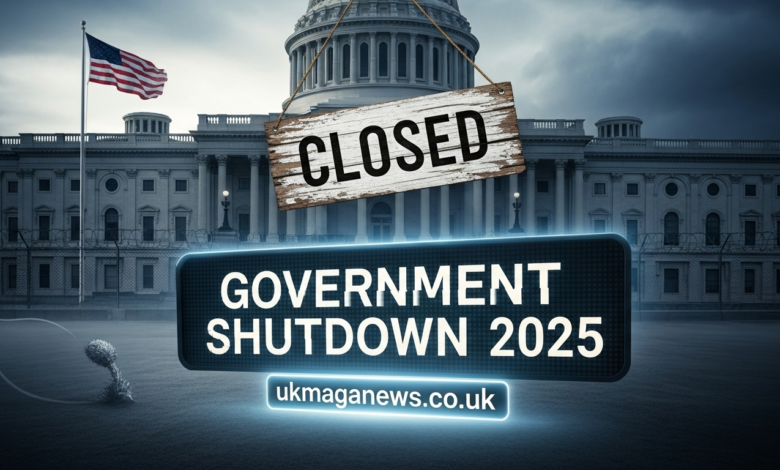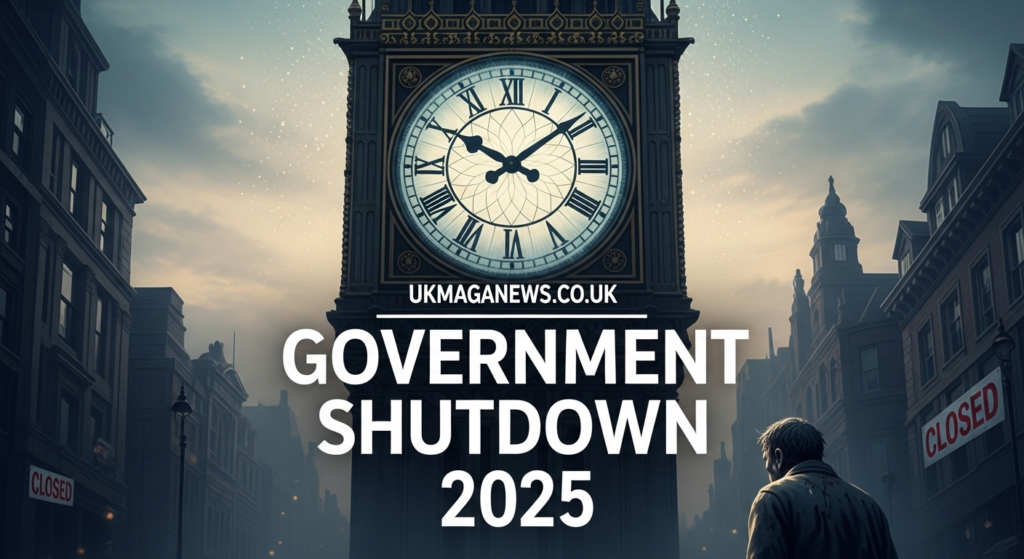Understanding the Government Shutdown 2025: Causes, Impacts, and Future Implications

Introduction to Government Shutdown
A government shutdown occurs when non-essential discretionary federal programs are unable to operate due to a lack of funding. This situation arises when the U.S. Congress fails to pass sufficient appropriations bills or continuing resolutions to finance government operations for a new fiscal year or a temporary period. Specifically, appropriations bills are essential legislative measures that allocate funding to specific agencies and programs, while continuing resolutions are temporary provisions that allow government operations to continue at existing funding levels when Congress is unable to agree on new appropriations.
Essentially, the shutdown acts as a consequence of a stalemate between the legislative and executive branches of government regarding fiscal policy and budgetary allocations. It highlights the importance of cooperation among lawmakers and the necessity of timely budget decisions to ensure the continuity of governmental functions. The federal budgeting process, which typically involves negotiations and compromises, can become contentious, leading to conflicts about spending priorities and policy issues, which may ultimately culminate in a shutdown.
During a government shutdown 2025, a significant number of federal employees are furloughed, and non-essential services may be suspended, impacting various sectors including public safety, healthcare, and infrastructure. Essential services, however, continue to operate, albeit with limitations, as they are funded through mandatory spending or prior appropriations. The legal framework surrounding government shutdown 2025 is rooted in the Antideficiency Act, which prohibits federal agencies from incurring obligations or making expenditures in excess of appropriations, thereby underscoring the critical nature of securing funding through congressional action.
The Causes of the Government Shutdown 2025
The government shutdown 2025 can be attributed to a convergence of political, economic, and social factors, reflecting a climate of heightened partisan tension and competing priorities within Congress. Central to this disruption was the inability of lawmakers to agree on budgetary allocations for the fiscal year. The budgetary impasse was largely driven by significant disagreements over federal spending, with divergent priorities highlighted by the two major parties. Democrats pushed for increased funding for social programs and infrastructure initiatives, while Republicans focused on fiscal restraint and tax reductions, creating a stalemate that ultimately led to the shutdown.
Moreover, broader economic conditions exacerbated the situation. In 2024, the nation faced a turbulent economic landscape marked by inflationary pressures and rising interest rates. These economic challenges intensified the debate over government funding and resource distribution, as lawmakers grappled with balancing economic growth initiatives against the backdrop of an increasing national deficit. Such tensions were further heightened by external pressures, including a global market downturn that raised questions about fiscal sustainability, complicating negotiations among partisan factions.
Social factors also played a crucial role in the lead-up to the shutdown. Public sentiment regarding government efficacy had reached a low point, fueled by a general mistrust in political institutions and dissatisfaction with legislative gridlock. Activist movements and public demonstrations increasingly called for accountability and responsive governance, placing additional pressure on elected officials. Consequently, these social dynamics contributed to a polarized environment in which compromise became increasingly elusive. In essence, the combination of partisan conflicts, economic instability, and evolving public expectations coalesced to precipitate the government shutdown 2025, highlighting the intricate interplay of various forces at work in American governance.
Timeline of the Government Shutdown 2025
The government shutdown2025 was the culmination of several significant events that unfolded over a series of months, highlighting critical legislative negotiations and decisions in Congress. The timeline began on January 15, 2025, when the new Congressional session commenced, bringing fresh faces and perspectives into the legislative arena. Key party leadership was established, setting the stage for upcoming debates on the federal budget.
As spring approached, the urgency surrounding budget discussions intensified. On March 15, 2025, House leaders introduced a preliminary budget proposal that sought to address various fiscal priorities, including defense spending, healthcare, and infrastructure. However, partisan divisions became evident, with Democratic and Republican lawmakers expressing starkly contrasting views on budget allocations. This discord was exacerbated by escalating tensions regarding the national debt ceiling, which was another crucial issue on the legislative agenda.
The situation reached a pivotal moment on June 20, 2025, when Senate hearings were held to evaluate the proposed budget. Key stakeholders, including the Treasury Secretary, provided testimony that underscored the potential risks of an unresolved budget. The anticipation for a resolution grew as July approached, and the deadline for passing a budget loomed nearer. On July 28, 2025, a bipartisan vote was attempted, but fell short as both parties failed to come to an agreement, leading to increased speculation about a possible shutdown.
As August 2025 arrived, political leaders began issuing urgent warnings. On August 15, Senate Majority Leader and House Speaker gave public statements urging parties to compromise, but these calls were met with little progress. Finally, on September 30, 2025, with no agreement reached, the government officially shut down, impacting countless federal services and employees. The timeline encapsulates the significant milestones that culminated in the shutdown, showcasing a complex interplay of legislative challenges and political dynamics.
Immediate Effects of the Shutdown
The government shutdown 2025 led to significant and immediate repercussions for federal employees, various services, and the economy at large. As the federal government ceased its operations, numerous agencies were directly impacted, experiencing disruptions that affected a wide range of programs and services. The Department of Education, the Environmental Protection Agency, and other key federal bodies faced the abrupt curtailment of their activities, which resulted in challenges in service delivery and operational capacity.
In terms of workforce, the shutdown resulted in the furlough of approximately 800,000 federal employees. These workers were effectively placed on unpaid leave, creating financial uncertainty for their families and contributing to a broader sense of instability within the federal workforce. Additionally, around 1.3 million employees were required to continue working without pay during the duration of the shutdown. This dual impact created a distressing atmosphere, as many federal employees were left grappling with operational uncertainties and the potential for delayed salaries.
The disruption in federal operations had ripple effects on public services. Many essential services were either suspended or significantly hampered. National parks and recreational areas, often considered focal points for tourism and local economies, closed their doors to visitors, while critical programs providing services such as food assistance and housing support experienced delays in processing and approvals. This upheaval not only hampered immediate access to services for affected populations but also contributed to a decline in public confidence in government efficiency.
The economic implications of the shutdown were substantial as well. With hundreds of thousands of federal employees missing paychecks and numerous agencies halting services, consumer spending saw a notable decline, thereby putting pressure on local economies. Overall, the immediate aftermath of the government shutdown 2025 showcased both the vulnerability of crucial federal functions and the significant dependence of the economy on government stability and operational continuity.

Public Response and Media Coverage
The government shutdown 2025 elicited a significant response from the public, as individuals and organizations reacted to the prolonged halt in federal operations. Public opinion polls taken during and after the shutdown indicated a diverse array of sentiments, with a notable percentage expressing frustration over the gridlock in Congress. Citizens were particularly concerned about how the shutdown affected essential services and federal employees, many of whom were left without pay. The shutdown sparked political discussions among constituents, with citizens urging their representatives to find collaborative solutions and avert similar scenarios in the future.
Moreover, grassroots protests emerged across various cities, demonstrating discontent with the current state of governance. Activist groups organized rallies that highlighted issues pertinent to the shutdown, such as the impact on social services, national security, and economic stability. Social media served as a vital platform for these protests, enabling rapid dissemination of information and fostering engagement among the younger demographic. Hashtags and trending topics related to the shutdown dominated online discussions, amplifying the call for accountability from elected officials.
Media coverage also played a pivotal role in shaping public perception of the shutdown. News outlets dedicated extensive coverage to the unfolding events, with countless articles, opinion pieces, and broadcasts dissecting the implications of the shutdown. Investigative reports illuminated the stories of affected workers and communities, bringing human faces to the abstract political crisis. Additionally, editorial perspectives often critiqued the political leadership and outlined potential resolutions, further sparking debates among the public. This comprehensive media landscape ensured that citizens remained informed, while also influencing how they viewed political accountability and responsibility in the context of governmental operations.
Long-term Implications for Federal Operations
The government shutdown 2025 has the potential for significant long-term consequences affecting federal operations, legislative processes, and inter-party relationships. Historically, government shutdown have not only disrupted services but have also resulted in lasting changes to the political landscape. The 2025 shutdown, in particular, may lead to a reevaluation of how budget negotiations are conducted in the future.
One immediate impact of the shutdown is the erosion of trust between political parties. The inability to reach a consensus on budgetary issues can foster an environment of hostility and increased polarization. As a result, bipartisan cooperation may become increasingly rare, complicating the passage of crucial legislation and reforms. Parties may be less willing to compromise, leading to future stalemates that could further paralyze federal operations.
Furthermore, the shutdown may create a precedent whereby lawmakers feel empowered to leverage budget negotiations as a political tool. This could lead to more frequent and prolonged shutdowns in the future, affecting various federal services and programs that depend on stable funding. Federal agencies could face operational disruptions that will require time to rectify, impacting long-term planning and management of public services.
In terms of policy-making, the fallout from the 2025 shutdown could result in a more fragmented approach to governance. With a focus on short-term fixes rather than long-term solutions, critical issues such as healthcare, infrastructure, and environmental protections may take a backseat to immediate political interests. This shift could cause the legislative process to become increasingly reactive and less strategic, ultimately hindering effective governance.
In conclusion, the long-term implications of the government shutdown 2025 on federal operations, legislative processes, and political relationships could be profound. As the political landscape evolves in response to these events, the challenge will be finding a way to foster cooperation and restore trust among lawmakers to effectively serve the American public.
Economic Consequences of the Shutdown
The government shutdown 2025 had significant economic repercussions that reverberated through various sectors, illustrating the interconnectedness of fiscal policy and economic stability. As federal agencies halted operations, numerous businesses reliant on government contracts and services faced immediate disruptions. This led to a decrease in productivity and potential job losses within the private sector, exacerbating uncertainty among employees and management alike.
One of the most critical indicators of the economic impact was the contraction in gross domestic product (GDP). Economists estimated that the partial shutdown could reduce GDP growth by up to 0.5% on an annualized basis. This figure reflects not just the direct effects on government spending but also the broader implications for consumer confidence and spending patterns. With federal workers furloughed, disposable income dwindled, leading to a decline in consumer spending—a crucial driver of economic growth. As spending decreased, businesses faced challenges in maintaining their revenue streams, prompting many to implement cost-cutting measures that further stifled economic activity.
Investor confidence also took a hit during this tumultuous period. The uncertainty surrounding the government shutdown 2025 raised concerns among investors about the stability of markets and the long-term economic outlook. Stock prices fluctuated, as market participants weighed the potential for prolonged disruptions against historical recovery patterns following similar events. Expert analyses suggested that sustained uncertainty could lead to decreased capital investment, which is vital for innovation and growth within various industries.
In summary, the government shutdown 2025 left a considerable dent in the economy, influencing GDP, consumer spending, and investor confidence. The combined effects served as a reminder of the potential economic fallout resulting from political impasses and the importance of stable governance for maintaining economic prosperity.
Lessons Learned from the 2025 Shutdown
The government shutdown2025 provides valuable insights into the dynamics of federal budgeting and appropriations processes. One of the key takeaways is the importance of proactive fiscal management. Policymakers are compelled to recognize that a failure to reach consensus on budgetary matters can lead to paralysis in government operations, impacting millions of citizens who depend on government services. This crisis emphasized the necessity for preventive measures, including the implementation of automatic continuing resolutions that would maintain government funding in the absence of an approved budget. Such mechanisms could mitigate the risk of future shutdowns, fostering stability in government services.
Additionally, the 2025 shutdown highlighted the need for improving civil discourse around budgeting issues. Engaging citizens in the budgetary process can increase awareness and understanding of governmental priorities and constraints. Educational initiatives that elucidate the implications of budget cuts or reallocations can empower constituents to advocate effectively for their needs. A well-informed public can advocate for smarter fiscal policies and encourage elected officials to seek compromise instead of entrenchment in partisan positions.
Moreover, enhancing transparency in government spending can lead to better accountability. Citizens are more likely to support necessary budget measures if they understand how funds are allocated and the rationale behind spending decisions. This transparency can be reinforced through the use of digital platforms that simplify complex financial data, making it more accessible and understandable to the general public.
Ultimately, the lessons from the 2025 shutdown center on the necessity for collaboration, transparency, and public engagement in the budgetary process. By addressing these areas, policymakers can not only avert future government shutdowns but also foster a more resilient and responsive governmental framework that serves the needs of all citizens effectively.
Looking Ahead: Future of Government Funding
The landscape of government funding in the post-2025 era will inevitably reflect the complexities of a rapidly changing political environment. With the experience of the government shutdown 2025 fresh in the minds of legislators, both sides of the aisle may be increasingly motivated to find pathways to bipartisan cooperation. One plausible scenario involves a renewed commitment to dialogue between Democrats and Republicans aimed at establishing a robust framework for long-term government funding. This collaboration could foster an environment where budgetary negotiations are prioritized, reducing the likelihood of future shutdowns.
However, the potential for bipartisan efforts may also be challenged by the dynamic nature of election cycles. As elections draw nearer, political parties often become more entrenched in their positions, making it increasingly difficult to reach compromises. The influence of party ideologies and pressure from constituents can lead to heightened partisan tensions, which in turn can precipitate crises over critical funding issues. It is essential to recognize that legislative challenges are likely to intensify, particularly in heated election years where both parties may leverage government funding discussions as pivotal campaign issues.
Moreover, existing socio-economic factors will play a critical role in shaping future government funding approaches. Emerging technologies, demographic shifts, and public health concerns will place additional pressures on government budgets. The response to these challenges may evoke discussions on the necessity of new funding models or reallocation of existing resources, potentially steering policy makers toward innovative solutions. While the path ahead may seem uncertain, understanding the implications of the past can serve as a guide to prevent future government shutdowns and foster a more stable fiscal environment in the years to come.



